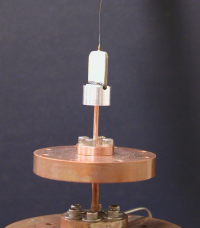October 15, 2012 report
Claim of supersolid helium disproved by original researcher

(Phys.org)—Moses Chan, co-author of a paper published in 2004 describing work that resulted in claims of the discovery of supersolid helium, has now co-authored another paper, published in Physical Review Letters, describing flaws in his original research. He and new colleague Duk Kim redesigned the original experiment: this time, they found no evidence of a supersolid.
Solid objects hold their shape due to a lattice structure made of atoms. Quantum theory suggests that under very cold conditions, quantum effects can cause some of the atoms in a structure to begin to move freely, thereby acting as a frictionless liquid, resulting in a supersolid.
Chan and his earlier partner Eunseong Kim believed they had proven the existence of supersolid helium after conducting an experiment that involved cooling helium that had been collected inside of a type of glass known as Vycor. The helium-glass mixture was hung from a chamber that was spun in first one direction, then the other, oscillating back and forth. As the temperature was brought down, the researchers noted that the oscillation rate increased. This, they claimed, was the result of some of the helium atoms inside slipping between the others in the lattice—a clear sign of a supersolid.
Three years later, a team led by John Beamish suggested that bulk helium, rather than becoming a supersolid as it was cooled, instead became stiffer, accounting for the increased oscillation rate found by Chan and Kim. Subsequent experiments by other researchers have found actual examples of this phenomenon and have since named it quantum plasticity.
Seeking to settle the matter once and for all, Chan and new partner Duk Kim redesigned the original experiment in a way that eliminated the possibility of bulk helium forming in a gap between the chamber and the helium-glass mixture. Doing so resulted in no increase in the rate of oscillation as the chamber was cooled. This result suggests that the increased oscillation rate of the earlier experiment was due to quantum plasticity, not the development of a helium supersolid.
This new research doesn't disprove theories regarding supersolids of course. Rather, it demonstrates that faulty research can sometimes lead to new discoveries such as, in this case, quantum plasticity.
More information: Absence of Supersolidity in Solid Helium in Porous Vycor Glass, Phys. Rev. Lett. 109, 155301 (2012) DOI: 10.1103/PhysRevLett.109.155301
Abstract
In 2004, Kim and Chan carried out torsional oscillator measurements of solid helium confined in porous Vycor glass and found an abrupt drop in the resonant period below 200 mK. The period drop was interpreted as probable experimental evidence of nonclassical rotational inertia. This experiment sparked considerable activities in the studies of superfluidity in solid helium. More recent ultrasound and torsional oscillator studies, however, found evidence that shear modulus stiffening is responsible for at least a fraction of the period drop found in bulk solid helium samples. The experimental configuration of Kim and Chan makes it unavoidable to have a small amount of bulk solid inside the torsion cell containing the Vycor disk. We report here the results of a new helium in Vycor experiment with a design that is completely free from any bulk solid shear modulus stiffening effect. We found no measurable period drop that can be attributed to nonclassical rotational inertia.
via Physics Focus
Journal information: Physical Review Letters
© 2012 Phys.org


















